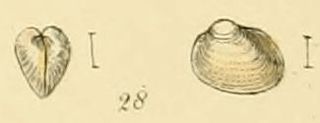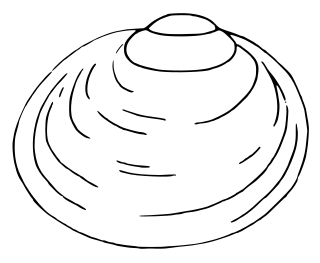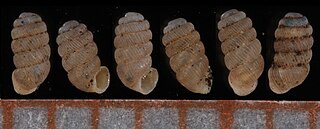
Ferberite is the iron endmember of the manganese - iron wolframite solid solution series. The manganese endmember is hübnerite. Ferberite is a black monoclinic mineral composed of iron(II) tungstate, FeWO4.

Jizera Mountains, or Izera Mountains, are part of the Western Sudetes on the border between the Czech Republic and Poland. The range got its name from the Jizera River, which rises at the southern base of the Smrk massif. The beech forests within the Jizera Mountains were added to the UNESCO World Heritage Site known as Ancient and Primeval Beech Forests of the Carpathians and Other Regions of Europe, because of their outstanding preservation and testimony to the ecological history of Europe since the Last Glacial Period.

The swan mussel, Anodonta cygnea, is a large species of freshwater mussel, an aquatic bivalve mollusc in the family Unionidae, the river mussels.

Pisidium casertanum, the pea cockle or pea clam, is a minute freshwater bivalve mollusc of the family Sphaeriidae.

Sphaerium rivicola, the river orb mussel, is a species of freshwater bivalve from family Sphaeriidae.

Pisidium hibernicum is a species of freshwater bivalve from the family Sphaeriidae.
Pisidium moitessierianum is a species of minute freshwater clam. It is an aquatic bivalve mollusc in the family Sphaeriidae.

Pisidium milium is a species of very small freshwater bivalve in the family Sphaeriidae, the fingernail clams and pea clams.

Pisidium obtusale is a species of freshwater bivalve from family Sphaeriidae.

Lucilla singleyana is a species of minute air-breathing land snail, a terrestrial pulmonate gastropod mollusc or micromollusk in the family Helicodiscidae.

Theodoxus danubialis is a species of small freshwater snail with an operculum, an aquatic gastropod mollusk in the family Neritidae, the nerites. The species is considered as endangered in Germany, Austria and in the Czech Republic.

Pupilla alpicola is a species of minute air-breathing land snail, a terrestrial pulmonate gastropod mollusk or micromollusk in the family Pupillidae.

Hauffenia sp. nov. is an as yet undescribed species of freshwater snail that lives underground, an aquatic gastropod mollusk in the family Hydrobiidae. This species is found in Slovakia.

Cochlodina costata is a species of air-breathing land snail, a terrestrial pulmonate gastropod mollusk in the family Clausiliidae, the door snails, all of which have a clausilium.

Valvata cristata is a species of minute freshwater snail with an operculum, an aquatic gastropod mollusk or micromollusk in the family Valvatidae, the valve snails.

Alzoniella slovenica is a species of very small or minute freshwater snail with an operculum, an aquatic gastropod mollusk in the family Hydrobiidae, which are sometimes known as the snouted water snails.
Ladislavella terebra is a species of air-breathing freshwater snail, an aquatic pulmonate gastropod mollusc in the family Lymnaeidae, the pond snails.

Truncatellina costulata is a species of very small air-breathing land snail, a terrestrial pulmonate gastropod mollusk in the family Truncatellinidae.

Pupilla pratensis is a species of minute air-breathing land snail, a terrestrial pulmonate gastropod mollusk or micromollusk in the family Pupillidae. This taxon was elevated to species level in 2009.


















